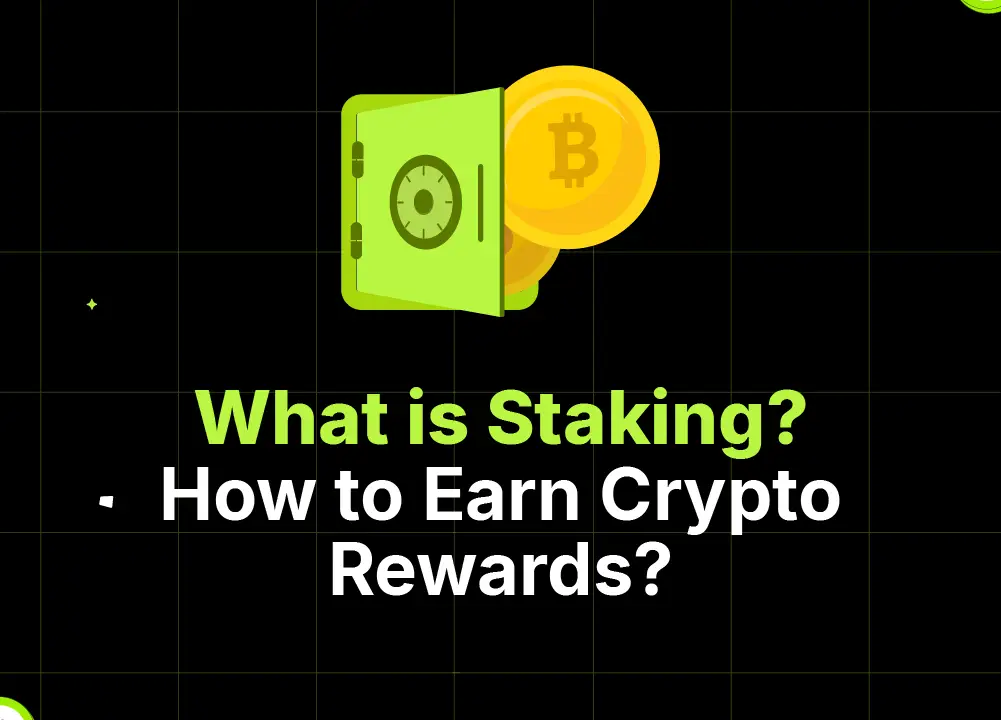
Over the past many years, staking has emerged as one of the most preferred ways of making money with cryptocurrencies with a long-term view. Staking stands out as a particularly intriguing method to earn rewards.
Ideal for those looking to generate income from their crypto holdings without selling them, staking is a crucial component of the Proof of Stake (PoS) mechanism.
This article will look into the concept of staking, how it works, and how you can use it to earn crypto rewards effectively.

Understanding Staking
Staking in the context of cryptocurrency is a process that involves committing your crypto assets to support a blockchain network and confirm transactions. It is primarily associated with cryptocurrencies that use a Proof of Stake (PoS) model, which is a more energy-efficient alternative to the Proof of Work (PoW) model used by Bitcoin.
How Does Staking Work?
Staking is a key process in many cryptocurrency networks, particularly those using a Proof of Stake (PoS) consensus mechanism. It involves committing a certain portion of cryptocurrency holdings to support network operations, which includes validating transactions and creating new blocks. This participation not only helps maintain the integrity and security of the blockchain but also rewards the stakeholders with additional cryptocurrency. Understanding how staking works is essential for anyone interested in the operational dynamics of PoS and similar systems.
The Process of Staking
The fundamental step in staking involves locking up a predefined amount of your cryptocurrency in a wallet specifically designed for this purpose. The act of locking up your coins is known as “staking” and it serves multiple crucial functions within the blockchain.
First, staking your cryptocurrency demonstrates your commitment to the network, acting as a form of security deposit. Participants who stake their coins are motivated to maintain network integrity because doing so ensures the value of their staked coins and their potential rewards.
Minimum Requirements
To participate in staking, you typically need to meet a minimum holding requirement. This requirement varies by blockchain and is meant to ensure that only serious and committed participants engage in the staking process. Once you’ve met this requirement, you can commit your coins by locking them in a personal wallet or joining a staking pool.

Personal Wallet vs. Staking Pool
Personal Wallet: Staking through a personal wallet involves setting up your own node or using a wallet that supports staking functionality. This method gives you full control over your staking activities but requires technical knowledge and can be resource-intensive, depending on the network.
Staking Pool
For those who either don’t meet the minimum staking requirements or prefer not to run their own node, staking pools are an attractive option. A staking pool allows multiple stakeholders to combine their holdings to meet staking thresholds and share the subsequent rewards. This pooling of resources generally results in a more stable income from staking activities, as rewards are distributed among all participants based on their staked amount.
Role in Network Security and Operations
Staked coins play a crucial role in maintaining the security and efficiency of the blockchain. In PoS systems, the blockchain protocol selects validators from among those who have staked coins. The chance of being chosen typically depends on the amount of cryptocurrency staked, although other factors like the length of time the coins have been staked can also influence this probability.
Once chosen, validators are responsible for checking the validity of new transactions, adding them to the blockchain, and creating new blocks. Successful block creation then leads to rewards, usually in the form of transaction fees or newly minted coins, which are distributed to the validators as a return on their investment.
Rewards and Incentives
The rewards received from staking serve as an incentive for users to lock up their funds and participate actively in network operations. These rewards compensate for the opportunity cost of locking the funds away and not using them for other purposes, such as trading. However, the exact nature and amount of the rewards can vary significantly between different cryptocurrencies and are influenced by factors such as network transaction volumes and inflation rates.
The Role of Validators
In PoS blockchains, validators play a crucial role. Instead of miners (as in PoW), validators are responsible for adding new transactions to the blockchain. The likelihood of being chosen to validate transactions generally depends on the amount of cryptocurrency staked. The more you stake, the higher your chances of being selected as a validator.
When transactions are validated, new blocks are added to the blockchain, and the validators receive rewards in the form of cryptocurrency. This reward is akin to interest earned in a traditional bank savings account, albeit typically at a much higher rate.
How to Start Staking
To begin staking, you must first ensure you have the right type of cryptocurrency for staking. Not all cryptocurrencies are stakable; only those using a PoS or a related consensus model can be staked.
Choosing a Cryptocurrency
Look for cryptocurrencies that not only allow staking but also have a strong network with a good track record and robust community support. Some popular stakable cryptocurrencies include Ethereum (post-ETH 2.0 upgrade), Tezos, and Cardano.

Selecting a Staking Method
There are generally two main ways to stake your crypto
Through a Staking Pool
Most individual investors find staking pools more accessible and practical. A staking pool involves joining forces with other coin holders to increase your chances of validating blocks and receiving rewards. It reduces the amount of crypto needed to participate and can provide more stable and consistent returns.
Solo Staking
If you have a significant amount of crypto and the necessary technical knowledge, you can stake solo. This means setting up and running a node on your own. Solo staking generally offers higher rewards since you don’t have to share them with others, but it also requires more resources and comes with higher risks.
Using a Crypto Wallet
A compatible crypto wallet is essential for staking. Some wallets are designed specifically for staking and provide tools to help manage and optimize your staking operations. Ensure that your wallet is secure, supports the cryptocurrency you plan to stake, and allows for staking directly or through a pool.
Risks and Considerations
While staking can be lucrative, it’s not without risks. The value of your staked coins can fluctuate, meaning the actual value of the rewards you earn could decrease if the price of the cryptocurrency falls. Additionally, staking funds are usually locked up for a period, during which you cannot sell them. There’s also the risk of network issues or errors in the staking setup that could affect rewards.
Key Takeaways
Staking is a powerful way to earn passive income from your cryptocurrency holdings while contributing to the operation and security of the blockchain network. By understanding how staking works, choosing the right currency, and using the appropriate staking method, you can start earning crypto rewards while helping to maintain the decentralized ethos of the crypto world. As always, it’s important to perform due diligence and consider the risks before diving in.
FAQs
1. What is staking in cryptocurrency?
Staking in cryptocurrency is the process of locking up a certain amount of your digital assets to participate in the operation and security of a blockchain network. It is primarily used in networks that operate on a Proof of Stake (PoS) consensus mechanism. By staking your coins, you help validate transactions, create new blocks, and maintain the network’s integrity.
2. How do I earn rewards from staking?
When you stake your cryptocurrency, you are essentially depositing it to help secure the network. As a reward for your contribution, the network pays you additional cryptocurrency. These rewards are similar to interest payouts and are distributed at intervals set by the respective blockchain protocol.
3. What are the requirements to start staking?
To start staking, you must first own a cryptocurrency that supports staking, typically one that uses a Proof of Stake or a similar consensus model. You will also need to meet the minimum staking amount required by the blockchain, which varies from one cryptocurrency to another.
4. Can I stake any type of cryptocurrency?
Not all cryptocurrencies can be staked. Only those that operate on a Proof of Stake or similar consensus mechanism support staking. Popular stakable cryptocurrencies include Ethereum (after the ETH 2.0 upgrade), Tezos, and Cardano.
5. What is the difference between staking in a personal wallet and a staking pool?
Staking through a personal wallet involves setting up your own node and staking your coins independently. This requires significant technical knowledge and resources but potentially offers higher rewards since you do not have to share them. Staking pools, on the other hand, involve pooling your resources with other stakeholders. This lowers the entry barrier and reduces the amount of cryptocurrency needed to participate, making it more accessible but also means sharing the rewards.
6. What risks are involved in staking?
The main risks of staking include the possibility of digital asset value fluctuation, which can affect the real value of your rewards. There’s also the “lock-up” period during which your assets are not liquid, meaning you cannot sell or move them. Additionally, if the network’s protocol is compromised or you choose an unreliable staking pool, you could lose part or all of your staked assets.
7. How does staking contribute to blockchain security?
Staking contributes to blockchain security by ensuring that those who validate transactions and create new blocks have a vested interest in the correct processing of transactions. Since validators risk losing their stake if they approve fraudulent transactions, they are incentivized to maintain network integrity.













9 replies on “What is Staking? How to Earn Crypto Rewards”
This blog has become a part of my daily routine I start my mornings with a cup of coffee and your latest post
Great insights! This really helped me understand the topic better. Thanks for sharing!
I just wanted to take a moment to express my gratitude for the great content you consistently produce. It’s informative, interesting, and always keeps me coming back for more!
Your blog post was really enjoyable to read, and I appreciate the effort you put into creating such great content. Keep up the great work!
Thanks for breaking this down. It was very helpful. nftbeyond.com
Your posts are always so relatable and relevant to my life It’s like you know exactly what I need to hear at the right time
Your writing is so powerful and has the ability to make a real difference in people’s lives Keep using your voice to spread kindness and positivity
Your blog post was really enjoyable to read, and I appreciate the effort you put into creating such great content. Keep up the great work!
Great insights, I really enjoyed reading your blog! Please check my post at https://mazkingin.com